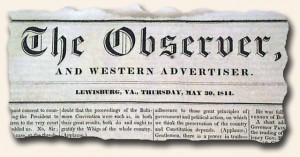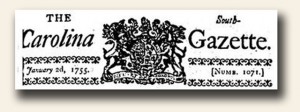West Virginia’s first newspapers…
January 28, 2013 by TimHughes · Leave a Comment
 The history of West Virginia newspapers dates some 70 years before West Virginia became a state. Statehood came late to West Virginia, carved from Virginia in the midst of the Civil War, happening officially on June 20, 1863. But its first newspaper began in 1790 when Nathaniel Willis began his “Potowmac Guardian & Berkeley Advertiser” at Shepherd’s-Town, near Harper’s Ferry. Less than two years later Willis moved the newspaper to Martinsburg.
The history of West Virginia newspapers dates some 70 years before West Virginia became a state. Statehood came late to West Virginia, carved from Virginia in the midst of the Civil War, happening officially on June 20, 1863. But its first newspaper began in 1790 when Nathaniel Willis began his “Potowmac Guardian & Berkeley Advertiser” at Shepherd’s-Town, near Harper’s Ferry. Less than two years later Willis moved the newspaper to Martinsburg.
The second newspaper was the “Shepherd’s Town, Charles-Town and County Advertiser” begun by Philip Rootes and Charles Blagrove on June 28, 1797. No copies beyond October 11, 1797 have been located. The third newspaper was the “Berkeley Intelligencer” done at Martinsburg on April 3, 1799 by John Alburtis. Many followed, including what is shown in the image, “The Observer, and Western Advertiser”, Lewisburg, [West] Virgina, 1884.
South Carolina’s first newspapers…
January 2, 2012 by TimHughes · Leave a Comment
The first two newspapers of South Carolina had feeble beginnings. In fact it is not known for certain which of the two was first.
Eleazer Phillips was named the official printer of the colony on Feb. 3, 1732, the son of a Boston bookseller & binder. He would die a few months later on July 10, 1732 & when his father traveled to Charleston to settle his son’s estate he address to its debtors the fact that his son had founded a newspaper, the “South Carolina Weekly Journal” sometime in January, 1732. But all copies of it have disappeared, also confirmed by Brigham.
 Thomas Whitmarsh began his “South Carolina Gazette” on January 8, 1732 which continued until his death in September of the following year. Did it begin before the “South Carolina Weekly Journal“? Odds are it did but with no issues of the latter existing it is not known for sure. Whitmarsh’s paper would begin again in February, 1734 by Lewis Timothy. He would die at the end of 1738 when it would be continued by his widow, Elizabeth Timothy. This newspaper would ultimately last until December, 1775 under this title.
Thomas Whitmarsh began his “South Carolina Gazette” on January 8, 1732 which continued until his death in September of the following year. Did it begin before the “South Carolina Weekly Journal“? Odds are it did but with no issues of the latter existing it is not known for sure. Whitmarsh’s paper would begin again in February, 1734 by Lewis Timothy. He would die at the end of 1738 when it would be continued by his widow, Elizabeth Timothy. This newspaper would ultimately last until December, 1775 under this title.
Celebrating 150 years since Arizona’s first newspaper…
November 2, 2009 by TimHughes · 2 Comments
The history of Arizona, an Indian word meaning “place of small springs”, goes back some 10,000 years B.C. with the arrival of the first Native Americans, while its history as recorded by Europeans dates to 1539 when the first white an, Marcus de Niza, a Franciscan friar arrived. It was organized as a territory in 1863 and admitted as a state in 1912, the last of the 49 contiguous states to join the Union.
Arizona’s first newspaper was the “Arizonian”, started at Tubac in March, 1859. Tubac lies about midway between Tucson and the Mexican border. For the following we credit Megan Thomas and the Chronkite News Service:
“For visitors at Tubac Presidio State Historic Park, (volunteer James) Pagels rolls ink and presses paper to metal to demonstrate a Washington Hand Press that was used to print the state’s first newspaper, “The Weekly Arizonian”. It still provides visitors with replicas of the paper.
“It’s living history,” Pagels said.
Arizona State Parks is preparing to celebrate the 150th anniversary of the arrival of the press in Arizona. Brought by ox cart from the Mexican port of Guaymas for William Wrightson of the Santa Rita Mining Co., the press turned out the first copy of the Arizonian on March 3, 1859, promoting the mining company and its agenda.
The “Arizonian” published out of Tubac for several months before moving to Tucson. According to an account by the late Douglas C. McMurtrie, a historian of printing in the U.S., the newspaper apparently ceased publication in the summer of 1860, resumed briefly in 1861 and resumed once again in 1867 – both times under different ownership – before finally folding for good in 1871. The press wound up in Tombstone, printing the Nugget newspaper for a time, and, according to McMurtrie, passed to the Arizona Historical Society in 1913.
Back home in Tubac and on permanent loan to Arizona State Parks, the press is a point of pride, said Joe Martinez, manager of the park.
“I think it’s amazing that the press came here in 1859 can still function today and we can show it to people and give them copies of the first edition,” Martinez said.
That edition describes attacks by Native Americans and crimes including horse thefts. It notes that stagecoaches were charging 40 cents to $1 per pound for extra baggage on runs between El Paso and San Diego. A section is devoted to the obituary of James Gadsden, who brokered the purchase from Mexico of nearly 30,000 square miles that are now part of southern Arizona and New Mexico.”


